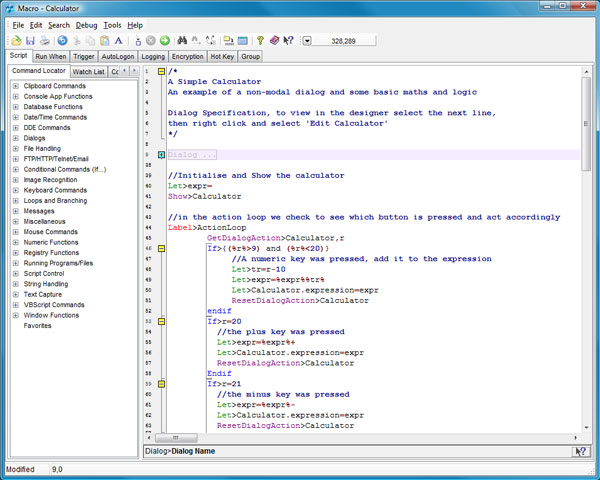By default in Macro Scheduler you do not have to do anything special to refer to a variable. The following will create a variable called Name:
Let>Name=Freddy
Name is now assigned the value of Freddy.
Referring to Variables:
The following will display a message box containing the word “Freddy”:
MessageModal>Name
Macro Scheduler knows that Name is a variable and finds its value. You do not need to tell it that Name is a variable. If Name did not exist as a variable the message box would simply display the word “Name”.
If you prefer you can tell Macro Scheduler that Name is a variable like so:
MessageModal>%Name%
But, by default (see below to see how to change this behaviour), there’s really no need since Name appears on its own.
However, supposing you wanted a message box that said “My Name is Freddy” and you wanted to use the variable “Name”. In this case you need to tell Macro Scheduler that Name is a variable, like so:
MessageModal>My Name is %Name%
Hopefully the reason is clear. If we did not put % symbols around the second “Name” the message box would simply display “My Name is Name”. Equally if Macro Scheduler tried to interpret every word as a variable we’d end up with “My Freddy is Freddy”.
Rule of thumb: % symbols really only need to be used when a variable appears within another string. When used on their own they are not needed.
Creating/Modifying Variables:
% symbols mean find the value of this variable. So when creating or modifying variables do not use them. E.g., the following assigns the value Freddy to the variable “Name”
Let>Name=Freddy
If you were to include Name in % symbols then you’d be saying “Assign Freddy to the value of Name”. This could get confusing. Consider the following code:
Let>Name=Sally
Let>%Name%=Freddy
Here we’d end up with two variables, one called Name assigned the value of Sally, and another called Sally assigned the value of Freddy. Now this can be quite powerful and there may be times you want to do this, but for most of us, it is usually not what we want.
Rule of thumb: Do not use % symbols when assigning to variables. This includes variables returned by other commands as well as variables on the left of the equals sign in Let commands.
There’s an interesting forum topic on this subject here.
Exceptions:
One time we DO want to use % symbols on the left side of a Let command is when we are creating/modifying array type variables and we are using an array counter. E.g.:
Let>x=0
Repeat>x
Let>x=x+1
Random>9,var
Let>Array[%x%]=var
Until>x=10
Here x is the loop counter. We are creating an array of 10 random values. In this case we want the value of x inside the array name and end up with variables Array[1], Array[2], Array[3], …. Array[10]. This is one case where we want a variable inside a variable.
Explicit Variable Resolution:
Real programmers prefer to tell the programming language when a value is a literal and when it is a variable, and as you get more advanced you may find the need to do that. You can tell Macro Scheduler to only resolve variables that are contained in % symbols and leave everything else as literals by setting VAREXPLICIT to 1:
Let>VAREXPLICIT=1
With this setting the following code will display the word “Name” in the message box:
Let>VAREXPLICIT=1
Let>Name=Fred
MessageModal>Name
Unlike before where we’d see “Fred” in the message box. Now to see the value of the Name variable we’d have to do:
MessageModal>%Name%
Note that when assigning to variables the variable name still appears on its own. Nothing changes in regards to creating or assigning to variables; only when referring to their values. The rules above still apply.
For more information see the following topics in the help file:
* User Defined Variables
* Explicit Variable Resolution
* Ignoring Spaces

